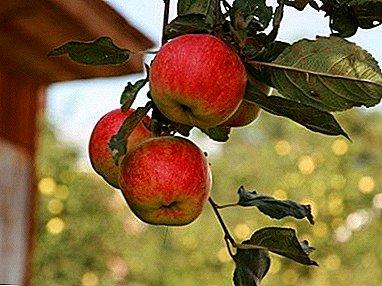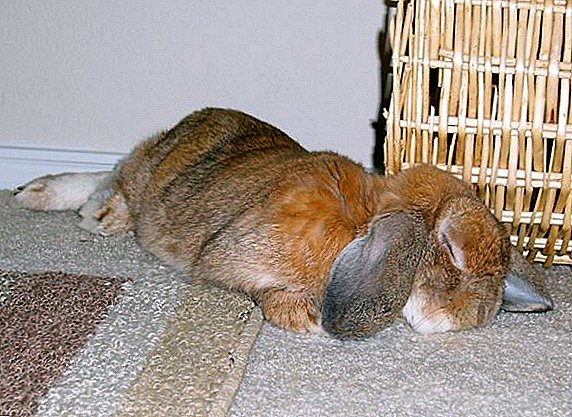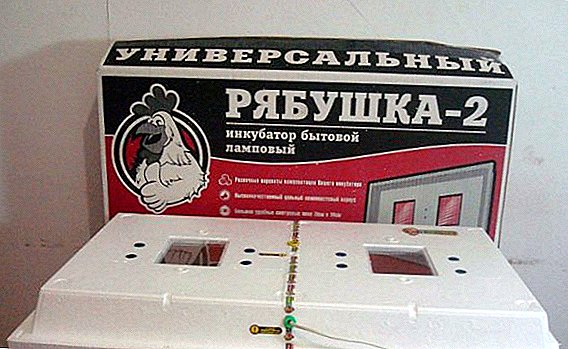 The purchase of a home incubator replaces the owners of laying poultry and allows you to get over 90% of offspring. According to reviews, if the farmer has the goal of breeding poultry, then the incubator will be a good investment, which will pay off in 2-3 times of its use. The range of devices for breeding chickens today is great. To understand it is quite difficult. In the article we offer you a description of one of the devices - "Ryabushka IB-130". You will learn how to handle it and how to achieve maximum breeding of chicks.
The purchase of a home incubator replaces the owners of laying poultry and allows you to get over 90% of offspring. According to reviews, if the farmer has the goal of breeding poultry, then the incubator will be a good investment, which will pay off in 2-3 times of its use. The range of devices for breeding chickens today is great. To understand it is quite difficult. In the article we offer you a description of one of the devices - "Ryabushka IB-130". You will learn how to handle it and how to achieve maximum breeding of chicks.
Description
The incubator (from the Latin. Іncubare - to hatch chicks) is an apparatus that, by maintaining constant temperature and humidity indices, allows artificially hatching of chicks from eggs of farm birds. The Ryabushka-2 130 incubator from the Ukrainian manufacturer UTOS (Kharkiv) serves to breed chicks in a small household.. It can lay the eggs of various poultry. Artificially raised chicks generally do not differ from those hatched.  "Ryabushka" is a small rectangular apparatus, made of high-quality extruded foam body in white in the form of a suitcase. The top cover is equipped with observation windows with the help of which one can observe the incubation process. With it, you can display young throughout the year. The number of incubations per year - 10.
"Ryabushka" is a small rectangular apparatus, made of high-quality extruded foam body in white in the form of a suitcase. The top cover is equipped with observation windows with the help of which one can observe the incubation process. With it, you can display young throughout the year. The number of incubations per year - 10.
Did you know? The simplest incubators were made by the ancient Egyptians over 3 thousand years ago. For heating eggs, they used straw burning. In European countries and in America, devices for breeding chicks began to be used en masse in the 19th century. In Russia, they began to be used in the first half of the 20th century.
Specifications
The incubator has small dimensions. Its weight is 4 kg, length - 84 cm, width - 48 cm, height - 21.5 cm. Such dimensions make it easy to carry the device from place to place. The incubator operates on 220 V mains. It consumes no more than 60 watts of power. Electricity for a 30-day incubation period consumes no more than 10 kW. The term of operation in compliance with the instructions - 10 years. Warranty - 1 year.
Production characteristics
The manufacturer on the package and in the instructions states that the incubator contains:
- chicken eggs - up to 130 pieces;
- ducks - up to 100;
- goose - up to 80;
- turkey - up to 100;
- quail - up to 360.
 However, the claimed amount of material contained corresponds to a manual turn. If it is planned to use a mechanical coup, then the following should be placed in the incubator:
However, the claimed amount of material contained corresponds to a manual turn. If it is planned to use a mechanical coup, then the following should be placed in the incubator:
- chicken eggs - up to 80;
- ducks - 60;
- turkey - up to 60;
- goose - up to 40;
- quail - up to 280.
Important! It is forbidden to lay eggs of different birds at one time, since each of them requires different parameters and duration of incubation. Thus, chicken eggs should be kept in the incubator for 21 days, duck and turkey - 28, quail - 17.
Incubator Functionality
Inside the device there are 4 40 W lamps for heating and 2 thermometers that allow you to control temperature and humidity. According to the manufacturer, the error in terms of air temperature can be no more than 0.25 °, humidity - 5%. Ventilation is carried out using special holes with plugs.
Thermoregulation - using the automatic thermostat. The incubation temperature is maintained at + 37.7-38.3 ° C. Depending on the model, the thermostat can be analog or digital. The optimum level of humidity is achieved due to the evaporation of water, which is poured into special vessels.  Trays for eggs in the middle of the device are missing. The incubation material is separated from each other by partitions in the form of wire. Mechanical coup regime. However, if it is not installed, the coup can be a manual one. There is also a model with an automatic egg flip and a digital thermostat.
Trays for eggs in the middle of the device are missing. The incubation material is separated from each other by partitions in the form of wire. Mechanical coup regime. However, if it is not installed, the coup can be a manual one. There is also a model with an automatic egg flip and a digital thermostat.
Advantages and disadvantages
Like any household appliance, the Ryabushka 130 incubator has both advantages and disadvantages. Among the advantages:
- high functionality;
- good yield of young animals;
- low price;
- small dimensions;
- reliability in operation;
- strength of materials;
- the convenience of use.
More information about such an incubator: "Blitz", "Universal-55", "Layer", "Cinderella", "Stimulus-1000", "Remil 550CD", "Egger 264", "Ideal hen".
Users note the following device drawbacks:
- To manual or mechanical coup should be adapted, do not forget to make it daily several times;
- difficulty washing

Instructions for the use of equipment
Before you start working with the incubator, you should read the instructions. The most common cause of damage or deterioration of the incubation material are incorrect actions of the owner of the device during its operation.
Preparing the incubator for work
In order to breed as many healthy chicks as possible, eggs should be selected before loading into the incubator. First of all, they must be fresh. Those copies that are stored for no longer than 4-6 days (turkey and goose - 6-8 days) at a temperature of + 8-12 ° C and humidity of 75-80% in a dark room are suitable for bookmarking. With each additional day of storage, egg quality will decline. So, during storage of incubation material for 5 days, hatchability will be 91.7%, within 10 days - 82.3%.  It is forbidden to wash the incubation material - at the same time you can wash off the protective layer, which will adversely affect the incubation. You should choose medium-sized eggs - weighing 56-63 g, without damaging the shell, without stains and dirt on it. You will also need an otoscope scan to determine the placement of the yolk, and disinfection with a solution of potassium permanganate or hydrogen peroxide. When viewed with an ovoskop, eggs should be discarded;
It is forbidden to wash the incubation material - at the same time you can wash off the protective layer, which will adversely affect the incubation. You should choose medium-sized eggs - weighing 56-63 g, without damaging the shell, without stains and dirt on it. You will also need an otoscope scan to determine the placement of the yolk, and disinfection with a solution of potassium permanganate or hydrogen peroxide. When viewed with an ovoskop, eggs should be discarded;
- with heterogeneous shell, thickenings, seals;
- whose airbag is not clearly visible at the blunt end;
- with uncharacteristic placement of the yolk - it should be located in the center or with a slight offset;
- with the quick movement of the yolk when turning.
Important! Some time before loading, the eggs are brought from the cool room where they were stored for warming up. Cold incubation material is forbidden to be placed in the incubator.Before loading the eggs, you should check whether the heating and humidity systems are working normally. To do this, you must enable an empty incubator so that it lasts for a day. After that, check the temperature and humidity levels.
 If everything is in order and the indicators are accurate or within the limits of the error stated by the manufacturer, then you can proceed to the next step - laying the incubation material. During incubation, the device should be in a room with an air temperature of + 15-35 ° C. It should be installed away from heating and heating devices, open fire, sunlight and drafts.
If everything is in order and the indicators are accurate or within the limits of the error stated by the manufacturer, then you can proceed to the next step - laying the incubation material. During incubation, the device should be in a room with an air temperature of + 15-35 ° C. It should be installed away from heating and heating devices, open fire, sunlight and drafts.Egg laying
In an incubation apparatus with a manual and mechanical coup system, the eggs are placed in a horizontal position with the pointed end up. In the device with an automatic coup - blunt end up. In the case of a manual overturning system, for convenience and better orientation, one should mark the side of the shell. Experienced poultry farmers are advised to bookmark the incubation material in the time span from 17 to 22 o'clock. So will be able to achieve day-speckling chicks.
Learn how to choose the right incubator for your home.
Incubation
Incubation of chicken eggs is divided into 4 periods:
- from 0 to 6 days;
- from the 7th to the 11th day;
- from the 12th until the sound of chicks;
- from the first sound to pecking.
 In the first period, the air temperature should be set at + 38 ° C, humidity - 60-70%. In the second period, the humidity should be maintained at a level slightly below 50%, the air temperature - + 37.5-37.7 ° C. The eggs are reversed every 3-4 hours. In the third period the following indicators should be established: temperature - + 37.3-37.5 ° С, humidity - 70-80%.
In the first period, the air temperature should be set at + 38 ° C, humidity - 60-70%. In the second period, the humidity should be maintained at a level slightly below 50%, the air temperature - + 37.5-37.7 ° C. The eggs are reversed every 3-4 hours. In the third period the following indicators should be established: temperature - + 37.3-37.5 ° С, humidity - 70-80%.Important! The operation of any incubator, even an automatic one, should be monitored every 8 hours.On the 18th day, ovoscopy is performed, discarding those eggs that do not contain an embryo. In the final period, the temperature is set at + 37.2 ° C, and the humidity at 78-80%. Turning no longer produce.
But add daily airing at least 2 times a day for 10-15 minutes. Do not be upset if the electric power is lost for some time. A short-term decrease in temperature in the incubator will not lead to deterioration of the incubation material. Eggs are more dangerous than overheating and dry air.
It will be interesting to know how to make the incubator device out of the fridge yourself.
Chick pecking
Sowing chicks should wait for the 20-21st day. As a rule, all chickens go out for one day. After hatching, young animals are selected, leaving chicks with strong legs, shiny down, active. After being rejected, they are kept in the incubator for some time to dry out. After that, move to a brooder. 
Device price
The price of the device with a mechanical coup is 650-670 hryvnia or 3470-3690 rubles and $ 25. A device with an automatic coup costs almost 2 times more expensive - 1,200 hryvnia or 5,800 rubles, $ 45.
Did you know? Despite the fact that the shell in the egg seems dense and solid, it lets the air through so that the chicken breathes. When viewed through a conventional magnifying glass, you can see a lot of pores in it. In the shell of chicken eggs, there are about 7.5 thousand. For 21 days, spent by a chicken in an egg, about 4 liters of oxygen enter it, and about 4 liters of carbon dioxide and 8 liters of water vapor evaporate from it.
findings
The Ryabushka 130 Incubator is worth buying for owners of small farms who plan to grow a small amount of young stock. It is easy to operate, lightweight and durable. The main advantages noted by people using it in the household are low price with high functionality. The device "Ryabushka" for 130 eggs is presented in 3 lines and price categories.
The difference lies in the device of the coup of eggs (manual, mechanical, automatic) and the technical characteristics of the thermostat (analog, digital). Some users on the web give advice on how to improve the device with their own hands so that it does not differ in functionality from more expensive and high-quality incubators.












